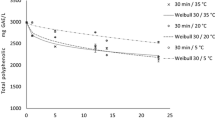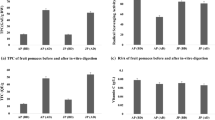Abstract
Fruit ripening induces changes that strongly affect their matrices, and consequently, the bioaccessibility/bioavailability of its phenolic compounds. Flesh from ‘slightly’ (SR), ‘moderately’ (MR) and ‘fully’ (FR) ripe ‘Ataulfo’ mangoes were physicochemically characterized, and digested in vitro to evaluate how ripening impacts the bioaccessibility/bioavailability of its phenolic compounds. Ripening increased the flesh’s pH and total soluble solids, while decreasing citric acid, malic acid and titratable acidity. MR and FR mango phenolics had higher bioaccessibility/bioavailability, which was related to a decreased starch and dietary fiber (soluble and insoluble) content. These results suggest that phenolics are strongly bound to the fruit’s matrix of SR mango, but ripening liberates them as the major polysaccharides are hydrolyzed, thus breaking covalent bonds and disrupting carbohydrate–phenolic complexes. There was also a higher release percentage in the gastric digestion phase, as compared to the intestinal. Our data showed that the bioaccessibility/bioavailability of mango phenolics depends on fruit ripening and on digestion phase.



Similar content being viewed by others
References
AOAC International (2016) Official methods of analysis of AOAC International, 20th edn. AOAC, Rockville
Bouayed J, Hoffmann L, Bohn T (2011) Total phenolics, flavonoids, anthocyanins and antioxidant activity following simulated gastro-intestinal digestion and dialysis of apple varieties: bioaccessibility and potential uptake. Food Chem 128:14–21
Cockburn DW, Koropatkin NM (2016) Polysaccharide degradation by the intestinal microbiota and its influence on human health and disease. J Mol Biol 428:3230–3252
Domínguez-Avila JA, Wall-Medrano A, Velderrain-Rodriguez GR, Chen CYO, Salazar-Lopez NJ, Robles-Sanchez M, Gonzalez-Aguilar GA (2017) Gastrointestinal interactions, absorption, splanchnic metabolism and pharmacokinetics of orally ingested phenolic compounds. Food Funct 8:15–38
Domínguez-Avila JA, Villegas-Ochoa MA, Alvarez-Parrilla E, Montalvo-Gonzalez E, González-Aguilar GA (2018) Interactions between four common plant-derived phenolic acids and pectin, and its effect on antioxidant capacity. J Food Meas Charact 12:992–1004
Domínguez-Rosas C, Domínguez-Avila JA, Pareek S, Villegas-Ochoa MA, Ayala-Zavala JF, Yahia E, Gonzalez-Aguilar GA (2018) Content of bioactive compounds and their contribution to antioxidant capacity during ripening of pineapple (Ananas comosus L.) cv. Esmeralda. J Appl Bot Food Qual 91:61–68
Esparza-Martinez FJ, Miranda-Lopez R, Guzman-Maldonado SH (2016) Effect of air-drying temperature on extractable and non-extractable phenolics and antioxidant capacity of lime wastes. Ind Crop Prod 84:1–6. https://doi.org/10.1016/j.indcrop.2016.01.043
Juaniz I et al (2017) Bioaccessibility of (poly)phenolic compounds of raw and cooked cardoon (Cynara cardunculus L.) after simulated gastrointestinal digestion and fermentation by human colonic microbiota (vol 32, pg 195, 2017). J Funct Foods 34:480. https://doi.org/10.1016/j.jff.2017.05.031
Kim H et al (2010) Antioxidant and antiproliferative activities of mango (Mangifera indica L.) flesh and peel. Food Chem 121:429–436. https://doi.org/10.1016/j.foodchem.2009.12.060
Núñez-Gastélum J, Alvarez-Parrilla E, de la Rosa L, Martínez-Ruíz N, González-Aguilar G, Rodrigo-García J (2015) Effect of harvest date and storage duration on chemical composition, sugar and phenolic profile of ‘Golden Delicious’ apples from northwest Mexico. N Z J Crop Hortic Sci 43:214–221
Ornelas-Paz JDJ, Failla ML, Yahia EM, Gardea-Bejar A (2008a) Impact of the stage of ripening and dietary fat on in vitro bioaccessibility of β-carotene in ‘Ataulfo’ mango. J Agric Food Chem 56:1511–1516
Ornelas-Paz JDJ, Yahia EM, Gardea AA (2008b) Changes in external and internal color during postharvest ripening of ‘Manila’ and ‘Ataulfo’ mango fruit and relationship with carotenoid content determined by liquid chromatography–APcI+-time-of-flight mass spectrometry. Postharvest Biol Technol 50:145–152
Palafox-Carlos H, Ayala-Zavala JF, González-Aguilar GA (2011) The role of dietary fiber in the bioaccessibility and bioavailability of fruit and vegetable antioxidants. J Food Sci 76:R6–R15
Palafox-Carlos H, Gil-Chavez J, Sotelo-Mundo RR, Namiesnik J, Gorinstein S, Gonzalez-Aguilar GA (2012a) Antioxidant interactions between major phenolic compounds found in ‘Ataulfo’ mango pulp: chlorogenic, gallic, protocatechuic and vanillic acids. Molecules 17:12657–12664
Palafox-Carlos H, Yahia E, Islas-Osuna MA, Gutierrez-Martinez P, Robles-Sánchez M, González-Aguilar G (2012b) Effect of ripeness stage of mango fruit (Mangifera indica L. cv. Ataulfo) on physiological parameters and antioxidant activity. Sci Hortic 135:7–13
Palafox-Carlos H, Yahia EM, Gonzalez-Aguilar GA (2012c) Identification and quantification of major phenolic compounds from mango (Mangifera indica, cv. Ataulfo) fruit by HPLC-DAD-MS/MS-ESI and their individual contribution to the antioxidant activity during ripening. Food Chem 135:105–111
Palafox-Carlos H, Contreras-Vergara C, Muhlia-Almazan A, Islas-Osuna M, Gonzalez-Aguilar G (2014) Expression and enzymatic activity of phenylalanine ammonia-lyase and p-coumarate 3-hydroxylase in mango (Mangifera indica ‘Ataulfo’) during ripening. Genet Mol Res 13:3850–3858
Pérez-Jiménez J, Díaz-Rubio ME, Saura-Calixto F (2013) Non-extractable polyphenols, a major dietary antioxidant: occurrence, metabolic fate and health effects. Nutr Res Rev 26:118–129
Pineda-Vadillo C et al (2016) vitro digestion of dairy and egg products enriched with grape extracts: effect of the food matrix on polyphenol bioaccessibility and antioxidant activity. Food Res Int 88:284–292
Quirós-Sauceda A et al (2014a) Dietary fiber and phenolic compounds as functional ingredients: interaction and possible effect after ingestion. Food Funct 5:1063–1072
Quirós-Sauceda AE, Ayala-Zavala JF, Sáyago-Ayerdi SG, Vélez-de La Rocha R, Sañudo-Barajas A, González-Aguilar GA (2014b) Added dietary fiber reduces the antioxidant capacity of phenolic compounds extracted from tropical fruit. J Appl Bot Food Qual 87:227–233
Rodríguez-Roque MJ, de Ancos B, Sánchez-Moreno C, Cano MP, Elez-Martínez P, Martín-Belloso O (2015) Impact of food matrix and processing on the in vitro bioaccessibility of vitamin C, phenolic compounds, and hydrophilic antioxidant activity from fruit juice-based beverages. J Funct Foods 14:33–43
Salazar-Lopez NJ, Astiazaran-Garcia H, Gonzalez-Aguilar GA, Loarca-Pina G, Ezquerra-Brauer JM, Avila JAD, Robles-Sanchez M (2017) Ferulic acid on glucose dysregulation, dyslipidemia, and inflammation in diet-induced obese rats: an integrated study. Nutrients 9:675
Samalova M, Mélida H, Vilaplana F, Bulone V, Soanes DM, Talbot NJ, Gurr SJ (2016) The β-1,3-glucanosyltransferases (Gels) affect the structure of the rice blast fungal cell wall during appressorium-mediated plant infection. Cell Microbiol 19:e12659. https://doi.org/10.1111/cmi.12659
Saura-Calixto F (2018) The story of the introduction of non-extractable polyphenols into polyphenol research: origin, development and perspectives, chap 1. In: Saura-Calixto F, Pérez-Jiménez J (eds) Non-extractable polyphenols and carotenoids: importance in human nutrition and health. Royal Society of Chemistry, UK, pp 1–16. https://doi.org/10.1039/9781788013208-00001
Saura-Calixto F, García-Alonso A, Goni I, Bravo L (2000) In vitro determination of the indigestible fraction in foods: an alternative to dietary fiber analysis. J Agric Food Chem 48:3342–3347
Singh J, Kaur L, Singh H (2013a) Food microstructure and starch digestion. Adv Food Nutr Res 70:137–179
Singh Z, Singh RK, Sane VA, Nath P (2013b) Mango: postharvest biology and biotechnology. Crit Rev Plant Sci 32:217–236. https://doi.org/10.1080/07352689.2012.743399
Velderrain-Rodríguez G et al (2014) Phenolic compounds: their journey after intake. Food Funct 5:189–197
Velderrain-Rodriguez G et al (2016) Effect of dietary fiber on the bioaccessibility of phenolic compounds of mango, papaya and pineapple fruits by an in vitro digestion model. Food Sci Technol 36:188–194
Wang J, Zhang Z, Huang R (2013) Regulation of ascorbic acid synthesis in plants. Plant Signal Behav 8:e24536. https://doi.org/10.4161/psb.24536
Wongmetha O, Ke L-S, Liang Y-S (2012) Sucrose metabolism and physiological changes during mango cv. Irwin growth and development. Hortic Environ Biotechnol 53:373–377
Wongmetha O, Ke LS, Liang YS (2015) The changes in physical, bio-chemical, physiological characteristics and enzyme activities of mango cv. **hwang during fruit growth and development. NJAS-Wagening J Life Sci 72–73:7–12. https://doi.org/10.1016/j.njas.2014.10.001
Yahia EM (2017) Fruit and vegetable phytochemicals: chemistry and human health, vol 2. Wiley, New York
Zaharah SS, Singh Z, Symons GM, Reid JB (2013) Mode of action of abscisic acid in triggering ethylene biosynthesis and softening during ripening in mango fruit. Postharvest Biol Technol 75:37–44. https://doi.org/10.1016/j.postharvbio.2012.07.009
Zhu F (2015) Interactions between starch and phenolic compound. Trend Food Sci Technol 43:129–143. https://doi.org/10.1016/j.tifs.2015.02.003
Acknowledgements
This work was funded by Consejo Nacional de Ciencia y Tecnología (CONACYT), through Project No. 563: “Un Enfoque Multidisciplinario de la Farmacocinética de Polifenoles de Mango Ataulfo: Interacciones Moleculares, Estudios Preclínicos y Clínicos”.
Author information
Authors and Affiliations
Corresponding author
Additional information
Publisher's Note
Springer Nature remains neutral with regard to jurisdictional claims in published maps and institutional affiliations.
Rights and permissions
About this article
Cite this article
Quirós-Sauceda, A.E., Sañudo-Barajas, J.A., Vélez-de la Rocha, R. et al. Effects of ripening on the in vitro antioxidant capacity and bioaccessibility of mango cv. ‘Ataulfo’ phenolics. J Food Sci Technol 56, 2073–2082 (2019). https://doi.org/10.1007/s13197-019-03685-x
Revised:
Accepted:
Published:
Issue Date:
DOI: https://doi.org/10.1007/s13197-019-03685-x




